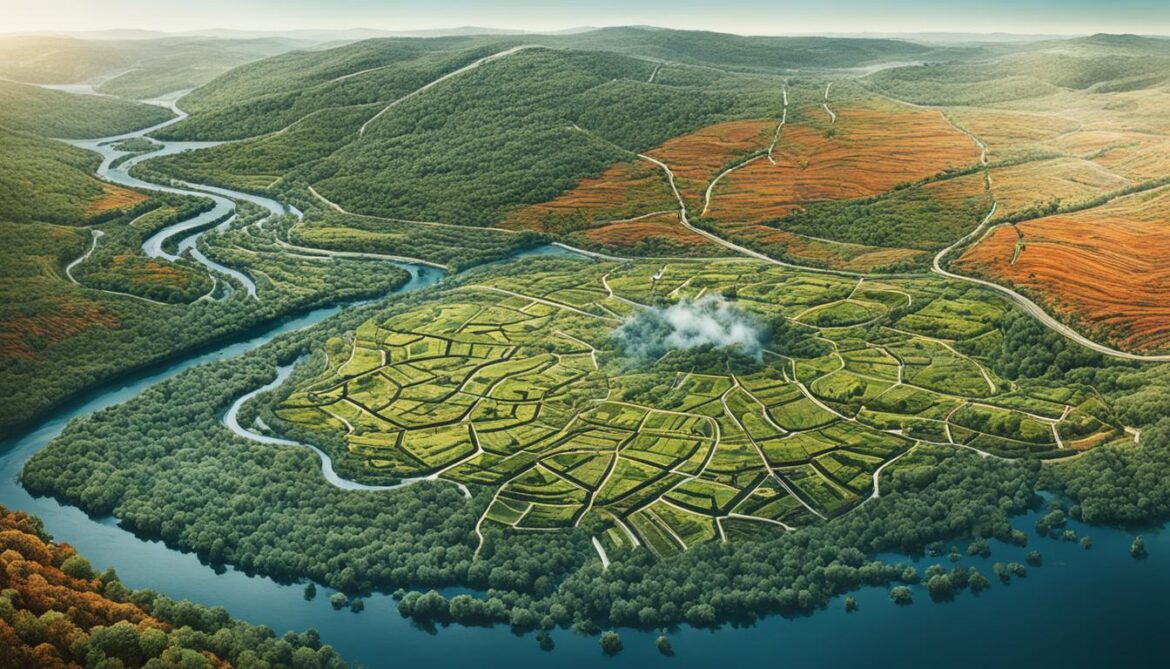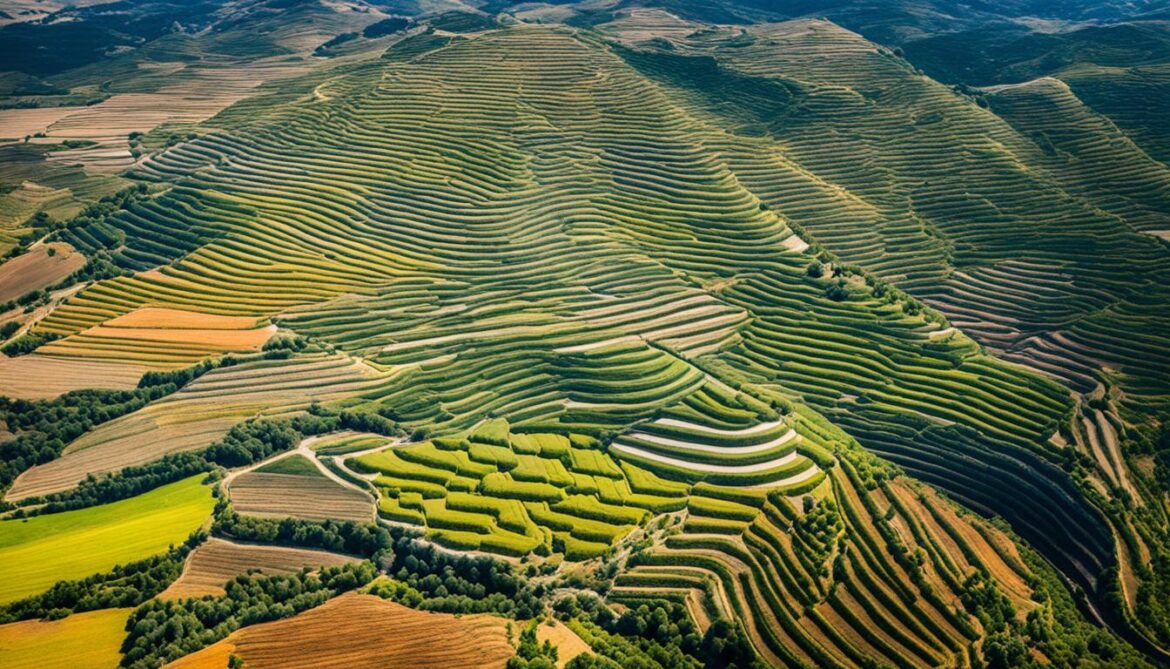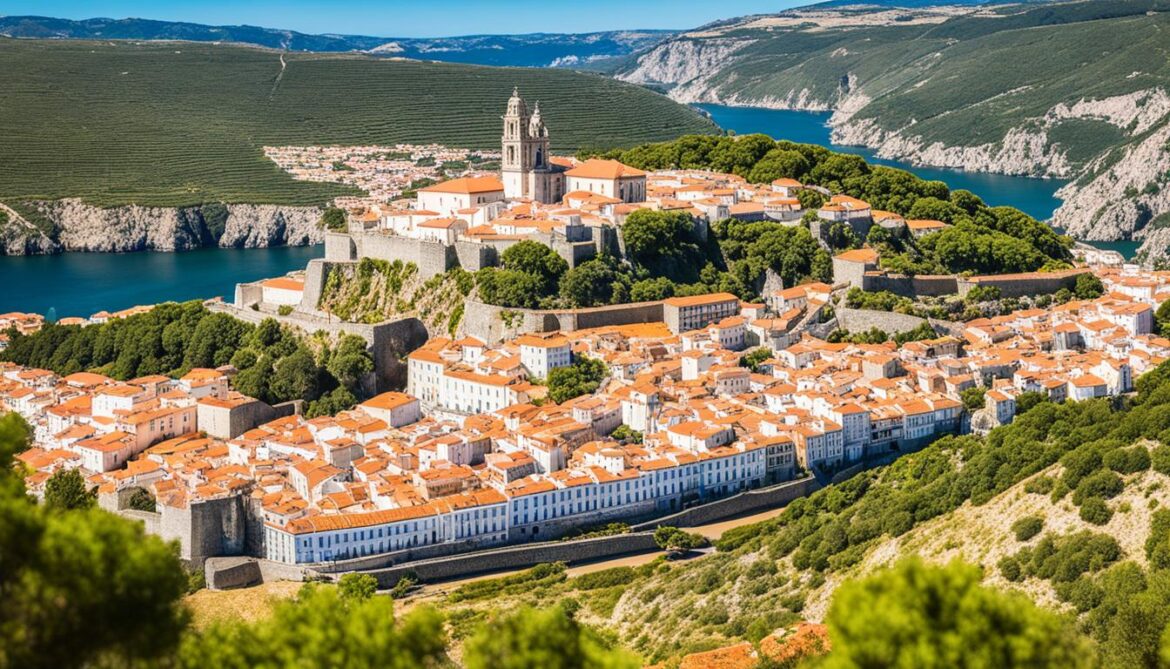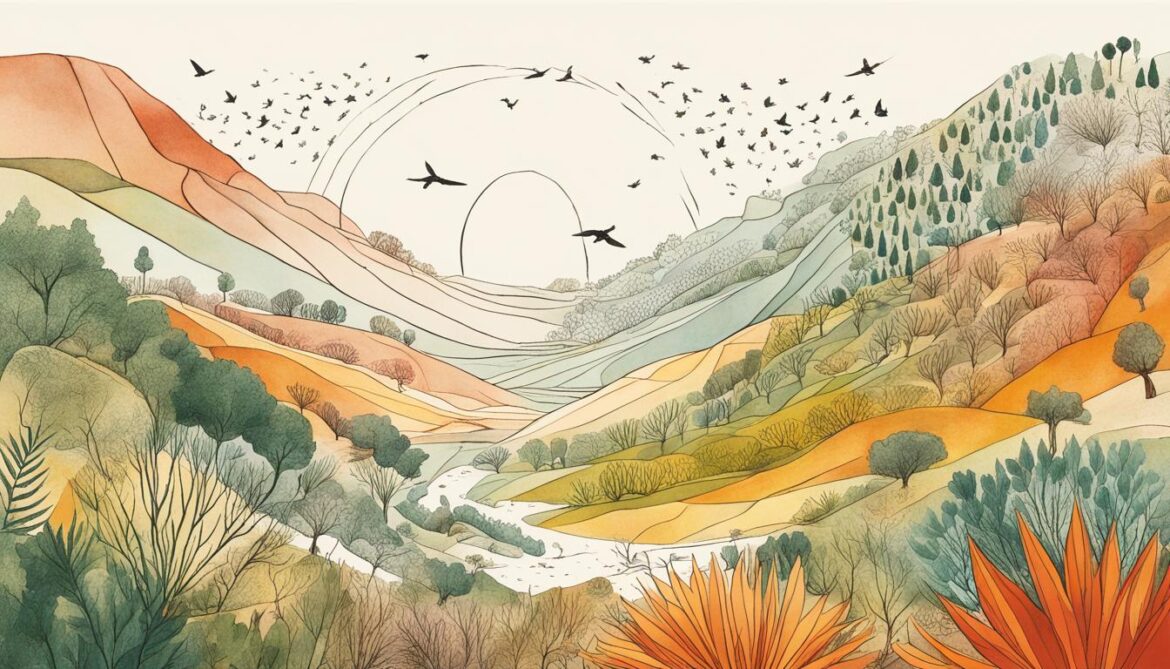Did you know that Portugal is home to approximately 3,600 species of plants and 313 bird species?
Portugal, located in southwestern Europe on the Iberian Peninsula, is known for its rich biodiversity and unique ecosystems. The country’s diverse landscapes, from rugged coastlines to lush forests, provide habitats for a wide range of plant and animal species. However, preserving this precious natural heritage is a challenge.
In this article, we will explore the sacred natural sites of Portugal and the importance of biodiversity conservation in the country. From the threats facing Portugal’s biodiversity to the conservation efforts and sustainable tourism practices, we will delve into the fascinating world of Portugal’s natural landscapes.
Key Takeaways:
- Portugal is home to approximately 3,600 species of plants and 313 bird species.
- Preserving Portugal’s natural heritage and biodiversity is crucial for the sustainable management of natural resources.
- Threats such as habitat loss, climate change, invasive species, and unsustainable human activities pose challenges to Portugal’s biodiversity.
- Conservation efforts, education, and public awareness are essential for protecting and preserving Portugal’s diverse ecosystems.
- Sustainable tourism practices can contribute to the conservation of Portugal’s natural sites while providing economic benefits.
Portugal’s Diverse Natural Heritage
Portugal’s geographical location and geophysical conditions contribute to its diverse natural heritage and rich biodiversity. The country is home to approximately 3,600 species of plants, including endemic species found nowhere else in the world. The flora in Portugal covers a wide range of species, providing a vibrant tapestry of colors and scents. Portugal also boasts an impressive array of terrestrial mammals, birds, amphibians, and reptiles. The Azores and Madeira archipelagos are notable biodiversity hotspots in Portugal, harboring a wealth of unique and endemic species.
https://www.youtube.com/watch?v=V_TsoVRvXLY
With its diverse landscapes and ecological niches, Portugal supports a wide variety of plant and animal life. From the lush forests of Peneda-Gerês National Park to the stunning coastal cliffs of the Algarve, Portuguese biodiversity is evident in every region. The rich wildlife in Portugal includes iconic species such as the Iberian lynx, golden eagle, imperial eagle, and the critically endangered Iberian wolf.
The flora in Portugal is equally diverse, encompassing a range of habitats like the Mediterranean scrubland, cork oak forests, and Atlantic temperate rainforests. These habitats support a plethora of plant species, from colorful wildflowers to towering trees. The cork oak forests, in particular, are an essential part of Portugal’s natural heritage, providing valuable habitats for many plant and animal species.
One of Portugal’s most significant natural heritage sites is the Azores archipelago in the Atlantic Ocean. This group of nine volcanic islands is considered one of the biodiversity hotspots in Portugal. The islands’ isolation and unique geological history have given rise to a wealth of endemic species, making the Azores a haven for biodiversity enthusiasts and researchers alike.
Threats to Portugal’s Biodiversity
Portugal’s biodiversity faces numerous threats that jeopardize the delicate balance of its ecosystems. These threats include habitat loss and degradation, climate change, invasive alien species, and unsustainable human activities.
Habitat Loss and Degradation
Habitat loss and degradation are major challenges in preserving Portugal’s biodiversity. Deforestation for agriculture, urbanization, and infrastructure development are significant contributors to the destruction of natural habitats. These activities disrupt the interconnectedness among species and interrupt critical ecological processes.
Climate Change
Climate change poses a significant threat to Portugal’s biodiversity. Rising temperatures, changing rainfall patterns, and more frequent extreme weather events impact the distribution and availability of resources for many species. These environmental changes force species to adapt or migrate, potentially disrupting entire ecosystems.
Invasive Alien Species
Invasive alien species are non-native organisms that cause harm to native ecosystems, often outcompeting and displacing native species. These invaders alter the balance of ecosystems, impacting biodiversity and ecosystem functions. Portugal faces the challenge of managing and controlling invasive species to protect its unique flora and fauna.
Unsustainable Human Activities
Unsustainable human activities, such as overexploitation of natural resources, pollution, and improper waste management, have detrimental effects on Portugal’s biodiversity. Overfishing, illegal wildlife trade, and pollution from industrial and agricultural sources contribute to the loss of species and disrupt ecological processes.
“The future of biodiversity in Portugal depends on our ability to address these threats and promote sustainable practices.”
Conservation efforts and awareness programs play a crucial role in protecting and preserving Portugal’s biodiversity. Initiatives focused on habitat restoration, reforestation, sustainable land management practices, and the control of invasive species are essential for maintaining the unique flora and fauna that make Portugal’s ecosystems thrive.

| Threats to Portugal’s Biodiversity |
Impact |
| Habitat loss and degradation |
Disruption of ecosystems, loss of native species |
| Climate change |
Changes in species distribution and abundance, disruption of ecological processes |
| Invasive alien species |
Competition with native species, alteration of ecosystems |
| Unsustainable human activities |
Destruction of habitats, pollution, overexploitation of resources |
Addressing these threats requires a coordinated effort involving government agencies, conservation organizations, and the public. Investing in research, education, and sustainable practices is crucial for the conservation of Portugal’s unique biodiversity and the protection of its natural heritage.
Conservation Efforts in Portugal
Portugal has made significant efforts to protect its biodiversity through the implementation of various conservation measures. One of the key initiatives is the National Biodiversity and Nature Conservation Strategy, which aims to safeguard the country’s natural treasures and promote sustainable use of its resources.
A major focus of the strategy is the identification and control of invasive species, which pose a significant threat to native flora and fauna. Control programs targeting invasive species have been successfully implemented in protected areas across Portugal, such as the Natural Park of Sintra-Cascais and the Natural Reserve of Paul do Boquilobo.
The Institute for Nature Conservation and Biodiversity plays a crucial role in managing and overseeing the implementation of conservation strategies in Portugal. It collaborates with various stakeholders, including government agencies, scientists, and local communities, to ensure the effective protection of biodiversity and the sustainable management of natural areas.
The conservation efforts in Portugal are guided by a comprehensive approach that integrates scientific knowledge, stakeholder engagement, and sustainable practices. This multi-faceted approach is essential for preserving the rich biodiversity and unique ecosystems that make Portugal a haven for nature enthusiasts and conservationists.
Protected areas are vital components of Portugal’s conservation efforts. These areas, including national parks, nature reserves, and protected landscapes, serve as sanctuaries for a wide range of species and ecosystems. They provide habitats for endangered and endemic species, as well as opportunities for research, education, and sustainable tourism.
The Role of Protected Areas in Biodiversity Conservation
Protected areas act as biodiversity hotspots, preserving critical habitats and enabling the conservation of rare and threatened species. In Portugal, they play a crucial role in protecting and restoring native plant communities, as well as conserving iconic species like the Iberian lynx and the Bonelli’s eagle.
The table below provides an overview of some of the key protected areas in Portugal:
| Protected Area |
Location |
Main Features |
| Serra da Estrela Natural Park |
Central Portugal |
Home to one of the largest protected areas in the country, featuring diverse ecosystems and the highest peak in mainland Portugal. |
| Ria Formosa Natural Park |
Algarve |
An important wetland system and a haven for bird migration, as well as supporting a rich marine biodiversity. |
| Berlenga Island Nature Reserve |
Peniche |
A UNESCO Biosphere Reserve and a crucial seabird nesting site, offering stunning coastal landscapes and underwater biodiversity. |
These protected areas, along with many others throughout Portugal, contribute to the conservation of the country’s diverse natural heritage and promote sustainable practices for the benefit of present and future generations.
Forest Cover and Biodiversity
Portugal’s land area encompasses approximately 41.3% of forests, contributing significantly to the country’s rich biodiversity. These forests provide vital habitats for a diverse array of plant and animal species, supporting the delicate balance of ecosystems. Among the forests, primary forests stand out for their exceptional ecological importance. These untouched and primeval ecosystems harbor unique species and play a fundamental role in maintaining biodiversity.

However, despite the crucial role they play, Portugal has experienced a decline in forest cover in recent years. This reduction in forested areas poses a threat to the conservation of biodiversity. Loss of forest cover leads to a loss of habitat, disrupting the intricate interactions between species and impacting the overall ecosystem balance.
Sustainable forest management practices are critically important in preserving Portugal’s forests and safeguarding the diverse plant and animal species they support. By implementing sustainable approaches, such as selective logging, reforestation, and the protection of sensitive areas, Portugal can ensure the long-term viability of its forests while simultaneously promoting biodiversity conservation.
Protected Areas and Biodiversity Conservation
In Portugal, the conservation of biodiversity is a top priority, and protected areas play a crucial role in achieving this goal. These areas are designated to safeguard ecosystems, preserve endemic and threatened species, and protect the country’s unique biodiversity hotspots. One of the significant categories of protected areas in Portugal is Indigenous and community conserved areas (ICCAs). These areas are managed by local communities and indigenous groups, who have traditional knowledge and practices that contribute to the conservation of biodiversity.

Protected areas in Portugal are also known as Other Effective Area-based Conservation Measures (OECMs) as they contribute significantly to the conservation of biodiversity outside of formally protected areas. These OECMs are diverse and include private reserves, sustainable tourism initiatives, and community-managed areas. Their collective efforts ensure that biodiversity conservation goes beyond traditional protected areas, creating a broader network of habitats and corridors for species to thrive.
The designation of protected areas in Portugal focuses on preserving and restoring sensitive ecosystems such as coastal areas, wetlands, and forests. By conserving these habitats, Portugal aims to maintain healthy ecosystems, provide essential services such as watershed protection, and safeguard biodiversity for future generations.
Sustainable Practices and Collaboration
The management and protection of protected areas rely on the collaboration of various sectors, including government agencies, local communities, NGOs, and researchers. Together, they work towards enhancing biodiversity conservation and promoting sustainable practices.
Collaboration across sectors is essential for effectively managing and protecting protected areas in Portugal. It ensures that conservation efforts are well-coordinated, resources are efficiently utilized, and the expertise of different stakeholders is leveraged for the benefit of biodiversity.
Educational initiatives and awareness programs play a vital role in promoting biodiversity conservation within protected areas. By providing information about the value of biodiversity and the importance of sustainable practices, these initiatives help foster a sense of responsibility among visitors and local communities.
Promoting Responsible Tourism
Protected areas in Portugal also offer opportunities for responsible tourism, which benefits both biodiversity conservation and the local economy. Sustainable tourism practices, such as low-impact accommodation, guided eco-tours, and environmental education programs, ensure that visitors can enjoy the natural beauty of these areas without causing harm to the environment.
Responsible tourism in protected areas promotes a deeper understanding and appreciation of biodiversity, helps generate income for local communities, and creates incentives for the conservation of natural resources.
The following table provides an overview of some of the key protected areas and biodiversity hotspots in Portugal:
| Protected Area |
Location |
Main Features |
| Serra da Estrela Natural Park |
Central Portugal |
High mountain range, unique flora and fauna |
| Ria Formosa Natural Park |
Algarve |
Coastal wetland, important bird habitat |
| Ria de Aveiro Protected Landscape |
Aveiro |
Coastal lagoon, diverse bird species |
| Peneda-Gerês National Park |
Northwest Portugal |
Mountainous region, ancient oak forests |
These protected areas showcase the diverse ecosystems and rich biodiversity that Portugal has to offer. They provide a haven for endemic and threatened species, as well as an opportunity for visitors to connect with nature and appreciate the country’s natural heritage.
Through the effective management of protected areas, collaboration between stakeholders, and promoting responsible tourism, Portugal continues to make strides in biodiversity conservation, ensuring the long-term sustainability of its natural resources.
Cultural and Historical Heritage Sites in Portugal
Portugal is home to a myriad of cultural and historical heritage sites that beautifully showcase the country’s rich history, while seamlessly intertwining culture and nature. These extraordinary sites have been rightfully recognized as UNESCO World Heritage sites, standing as testaments to the exceptional value and universal significance they possess. Each of these sites preserves invaluable architectural and artistic treasures, offering visitors invaluable insights into the revered cultural and natural heritage of Portugal.
UNESCO World Heritage Sites in Portugal
“The historic center of Guimarães, the historic center of Porto, the Convent of Christ in Tomar, and the Monastery of Alcobaça are among the many incredible UNESCO World Heritage sites found in Portugal. Each of these sites provides a window into the country’s rich past and cultural tapestry, captivating visitors with their unique charm and historical significance.”
The Historic Centre of Guimarães, situated in the north of Portugal, is a prime example of medieval urbanism and the birthplace of the nation. Its remarkably preserved buildings and streets harken back to the Middle Ages, creating an immersive experience for history enthusiasts. Similarly, the Historic Centre of Porto, with its labyrinthine alleys and breathtaking architecture, offers a captivating glimpse into the country’s maritime tradition and grandeur.
The Convent of Christ in Tomar, a stunning example of medieval architecture, serves as a testament to Portugal’s rich Templar heritage. Its intricate Manueline-style detailing is a sight to behold, pulling visitors into a world of grandeur and religious devotion. The Monastery of Alcobaça, a sublime example of Cistercian Gothic architecture, whispers tales of love, tragedy, and immense cultural significance.
These UNESCO World Heritage sites in Portugal are not mere structures frozen in time; they are living testaments to the country’s extraordinary cultural and historical legacy. The preservation and celebration of these sites allow both locals and visitors to experience the magnificence of the past and appreciate the deep-rooted connection between culture and nature.

| UNESCO World Heritage Site |
Location |
Description |
| Historic Centre of Guimarães |
Guimarães, northern Portugal |
A well-preserved medieval center, considered the birthplace of Portugal |
| Historic Centre of Porto |
Porto, northern Portugal |
An enchanting cityscape with centuries-old architecture and a rich maritime history |
| Convent of Christ in Tomar |
Tomar, central Portugal |
A magnificent medieval monastery reflecting Portugal’s Templar heritage |
| Monastery of Alcobaça |
Alcobaça, central Portugal |
A Cistercian Gothic masterpiece with a poignant historical significance |
Implications for Conservation and Future Directions
The conservation of sacred natural sites in Portugal holds significant implications for the preservation of biodiversity and the sustainable management of natural resources. These sites, often characterized by their cultural and historical significance, play a crucial role in maintaining the ecological balance and protecting rare and endangered species.
By integrating cultural and natural heritage in conservation strategies, Portugal can enhance the effectiveness of its conservation efforts. Recognizing the interconnectedness of cultural and natural values fosters a holistic approach to biodiversity preservation, ensuring not only the protection of unique species and ecosystems but also the safeguarding of cultural traditions and identities.
Integrating cultural and natural heritage in conservation strategies is like weaving together the threads of our past and present, creating a tapestry of sustainability and resilience.
Enhancing Public Awareness and Education
Public awareness and education are integral to fostering a sense of responsibility and encouraging sustainable practices among the general public and policymakers. By raising awareness about the value of biodiversity and the importance of its conservation, Portugal can inspire individual and collective actions towards a more environmentally conscious society.
Educational initiatives, such as school programs, public campaigns, and interactive exhibits, can provide accessible platforms to engage people of all ages in learning about biodiversity and its relevance to their daily lives. Additionally, partnerships between conservation organizations, educational institutions, and local communities can facilitate the dissemination of knowledge and the promotion of sustainable behaviors.
Collaboration for Effective Conservation
Effective conservation of Portugal’s biodiversity requires collaboration among different stakeholders, including communities, conservation organizations, and government agencies. By working together, these entities can pool their resources, expertise, and perspectives to develop innovative and inclusive conservation strategies.
Local communities, who have a deep connection to the land and its sacred natural sites, play a vital role in conservation efforts. Their traditional knowledge, practices, and sustainable land management techniques can contribute significantly to biodiversity preservation. Collaborative governance models that involve local communities in decision-making processes can ensure the long-term sustainability of conservation initiatives.
Conservation organizations and government agencies can provide technical support, funding, and policy frameworks to facilitate the implementation of conservation projects. By creating partnerships and fostering dialogue, these entities can mobilize resources and coordinate conservation actions on a larger scale.

By embracing these implications for conservation and charting future directions, Portugal can pave the way towards a more sustainable and biodiverse future. The integration of cultural and natural heritage, public awareness, and collaboration among stakeholders will create a solid foundation for the effective protection and management of Portugal’s sacred natural sites and biological treasures.
Conclusion
Portugal’s sacred natural sites and biodiversity contribute to its unique and valuable natural heritage. The country’s diverse ecosystems, rich flora and fauna, and cultural and historical heritage sites make it a haven for biodiversity and offer endless opportunities for sustainable tourism. However, like many other regions, Portugal faces challenges in preserving its biodiversity.
Habitat loss, climate change, invasive species, and unsustainable human activities are significant threats to Portugal’s biodiversity. It is crucial for conservation efforts, education, and public awareness to come together to protect and manage Portugal’s natural resources in a sustainable manner. By recognizing the cultural and ecological value of sacred natural sites and actively promoting their conservation, Portugal can ensure the preservation of its remarkable natural beauty for future generations.
The conservation of Portugal’s sacred natural sites and biodiversity is not only a responsibility but also an opportunity. It allows us to safeguard the delicate balance of ecosystems, protect endangered species, and promote sustainable practices. By working together, we can create a future where Portugal’s natural heritage thrives, ensuring the well-being and enjoyment of both current and future generations.
FAQ
What is Portugal’s diverse natural heritage?
Portugal’s diverse natural heritage includes approximately 3,600 species of plants, 69 terrestrial mammal taxa, 313 bird species, and numerous amphibian and reptile species. The country is also home to endemic species found nowhere else in the world.
What are the threats to Portugal’s biodiversity?
The threats to Portugal’s biodiversity include habitat loss and degradation, climate change, invasive alien species, and unsustainable human activities such as overexploitation of natural resources, pollution, and improper waste management.
What conservation efforts are in place in Portugal?
Portugal has implemented the National Biodiversity and Nature Conservation Strategy, which focuses on identifying and controlling invasive species. The country also has protected areas managed by the Institute for Nature Conservation and Biodiversity, where conservation measures are implemented.
How important are forests in preserving biodiversity in Portugal?
Forests cover approximately 41.3% of Portugal’s land area and are essential in preserving biodiversity. Sustainable forest management practices are crucial in protecting the diverse plant and animal species supported by the forests.
What is the significance of protected areas in biodiversity conservation in Portugal?
Protected areas, including Indigenous and community conserved areas (ICCAs), serve as important biodiversity hotspots in Portugal. They preserve endemic and threatened species and protect sensitive ecosystems.
What are some of the cultural and historical heritage sites in Portugal?
Portugal is home to UNESCO World Heritage sites such as the Historic Centre of Guimarães, Historic Centre of Porto, Convent of Christ in Tomar, and Monastery of Alcobaça. These sites preserve architectural and artistic treasures and offer insights into the cultural and natural heritage of Portugal.
How can the conservation of sacred natural sites contribute to biodiversity preservation in Portugal?
Recognizing and conserving sacred natural sites can enhance the effectiveness of conservation efforts in Portugal. Integrating cultural and natural heritage in conservation strategies promotes sustainable practices and fosters a sense of responsibility among the public and policymakers.
What are the implications for conservation and future directions in Portugal?
The implications for conservation in Portugal include enhancing public awareness, promoting sustainable practices, and collaborating between different stakeholders such as communities, conservation organizations, and government agencies. These efforts are crucial for the effective conservation of Portugal’s biodiversity.























Post comments (0)